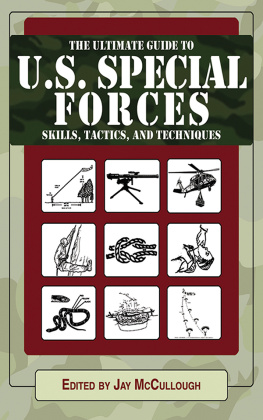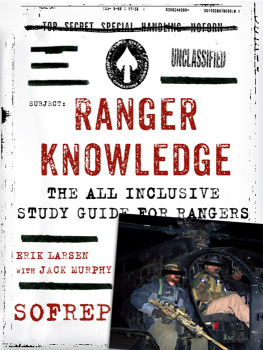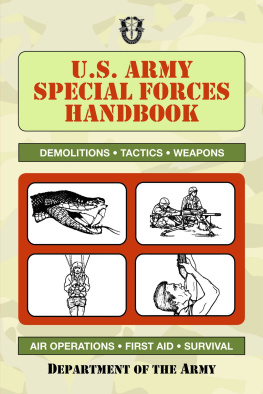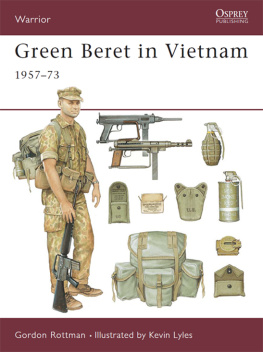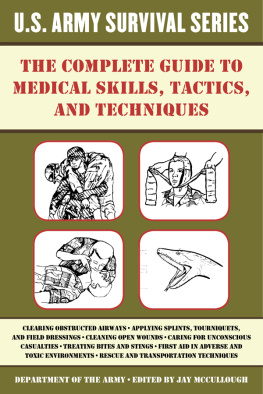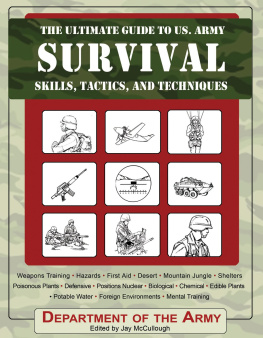The Ultimate Guide to
U.S. Special Forces
Skills, Tactics, and Techniques
Edited by
Jay McCullough

Skyhorse Publishing
Copyright 2012 by Skyhorse Publishing, Inc.
No claim is made to material contained in this work that is derived from government documents. Nevertheless, Skyhorse Publishing, claims copyright in all additional content, including, but not limited to, compilation copyright and the copyright in and to any additional material, elements, design, or layout of whatever kind included herein.
All Rights Reserved. No part of this book may be reproduced in any manner without the express written consent of the publisher, except in the case of brief excerpts in critical reviews or articles. All inquiries should be addressed to Skyhorse Publishing, 307 West 36th Street, 11th Floor, New York, NY 10018.
Skyhorse Publishing books may be purchased in bulk at special discounts for sales promotion, corporate gifts, fund-raising, or educational purposes. Special editions can also be created to specifications. For details, contact the Special Sales Department, Skyhorse Publishing, 307 West 36th Street, 11th Floor, New York, NY 10018 or .
Skyhorse and Skyhorse Publishing are registered trademarks of Skyhorse Publishing, Inc., a Delaware corporation.
Visit our website at www.skyhorsepublishing.com.
10 9 8 7 6 5 4 3 2
Library of Congress Cataloging-in-Publication Data is available on file.
ISBN: 978-1-61608-208-6
Printed in Canada
INTRODUCTION
TK
Jay Mccullough
November 2009
North Haven, Connecticut
One If By Sea:
Special Forces Waterborne Operations
CHAPTER 1
Mission Planning
Special Forces operational detachments A (SFODAs) must conduct a detailed mission analysis to determine an appropriate method of infiltration. SF maritime operations are one of the many options available to a commander to infiltrate and exfiltrate a detachment into (or out of) a designated area of operations (AO) for the purpose of executing any of the SF missions. A thorough understanding of all factors impacting waterbornerelated missions is essential due to the inherently higher levels of risk associated with even the most routine waterborne operations. The objective of this chapter is to outline mission, enemy, terrain and weather, troops and support availabletime available and civil considerations (METT-TC) and planning considerations needed to successfully execute all types of waterborne operations.
PERSPECTIVE
1-1. Over five-eighths of the earths surface is covered by water. SF units conduct waterborne operations to infiltrate a designated target area from these water-covered areas. Regardless of whether an AO has exposed coastlines, coastal river junctions, or harbors, many areas will have large rivers, lakes, canals, or other inland waterways located within their boundaries. These maritime or riverine features represent exploitable characteristics that special operations forces (SOF) can use to their advantage.
1-2. Throughout the world, military equipment sales programs by various countries have caused a proliferation of advanced radar technologies and coastal air defense systems. As local governments seek to exercise greater control over their indigenous territories, these facilities and the associated risks to SOF units normal means of infiltration and exfiltration will continue to increase. Waterborne infiltrations and exfiltrations keep the highvalue air, surface, or subsurface infiltration assets offshore and out of the detection and threat ranges of coastal defense installations.
1-3. Waterborne operations are a means to an end. Despite the increased use of sophisticated coastal surveillance systems and active surface and air interdiction efforts on the part of regional governments, local inhabitants continue to engage in various illicit activities; for example, smuggling and illegal fishing just as their forebears have for centuries. In many parts of the world, long coastlines, extensive waterways, and small undermanned and underpaid navies exacerbate these problems. The clandestine nature and high probability of success for these illicit operations mirrors SF units requirements for successful infiltrations into, or exfiltrations out of, potentially hostile areas of responsibility (AORs).
1-4. Personnel involved in waterborne operations require extensive knowledge of hydrography, meteorology, navigation, and maritime operations (MAROPS). They must be able to conduct realistic premission training, gather information, plan, rehearse, and use the appropriate waterborne operations technique to accomplish their assigned mission.
1-5. Commanders use sophisticated techniques and equipment to conduct waterborne operations. When used correctly, these factors give commanders another means to move teams and influence the battlefield. The skills and techniques used in waterborne operations are equally applicable to all SF missions, especially direct action (DA), special reconnaissance (SR), unconventional warfare (UW), and foreign internal defense (FID). Internal mission support taskings and humanitarian assistance (HA) missions may also require waterborne operations capability.
METT-TC
1-6. The successful execution of any operation is directly related to thorough and detailed planning. Mission planning begins with a detailed analysis of METT-TC questions (), with qualifiers pertaining to waterborne operations, that the SFODA must consider when selecting a method of infiltration.
Table 1-1. METT-TC analysis
| Factors | Questions |
| Mission | - What is the specified mission?
- What are the implied missions?
- Is the objective within range of a coastline or waterway that a detachment can use as a route to infiltrate the AOR?
|
| Enemy | - What are the ranges of enemy detection capabilities?
- Does the enemy have the ability to detect or interdict conventional iSYMBOLS AND ABBREVIATIONSnfiltration techniques; for example, static-line parachute, high-altitude low-opening (HALO) parachute technique, or air-mobile insertion?
- Does the enemy have an extensive coastline or internal waterways that are vulnerable to a maritime or waterborne infiltration?
- Is the enemy capable of detecting and interdicting U.S. maritime assets outside the range of the detachments intermediate (or final) transport method?
|
| Terrain and Weather | - Is the weather conducive to a maritime operation?
- Are sea states within the operational limits of the detachments chosen infiltration method?
- Are any weather patterns expected in the AO that might cause unacceptable sea conditions?
- What is the percentage of illumination? Can the detachment infiltrate during periods of limited visibility and illumination?
- Are the tides and currents favorable during the desired infiltration window?
- Are there suitable primary and alternate beach landing sites (BLSs) available to the detachment?
- What are the surf conditions at the tentative BLS?
|
| Troops and Support Available | - Does the detachment have the training and experience to successfully execute the selected infiltration method?
|

